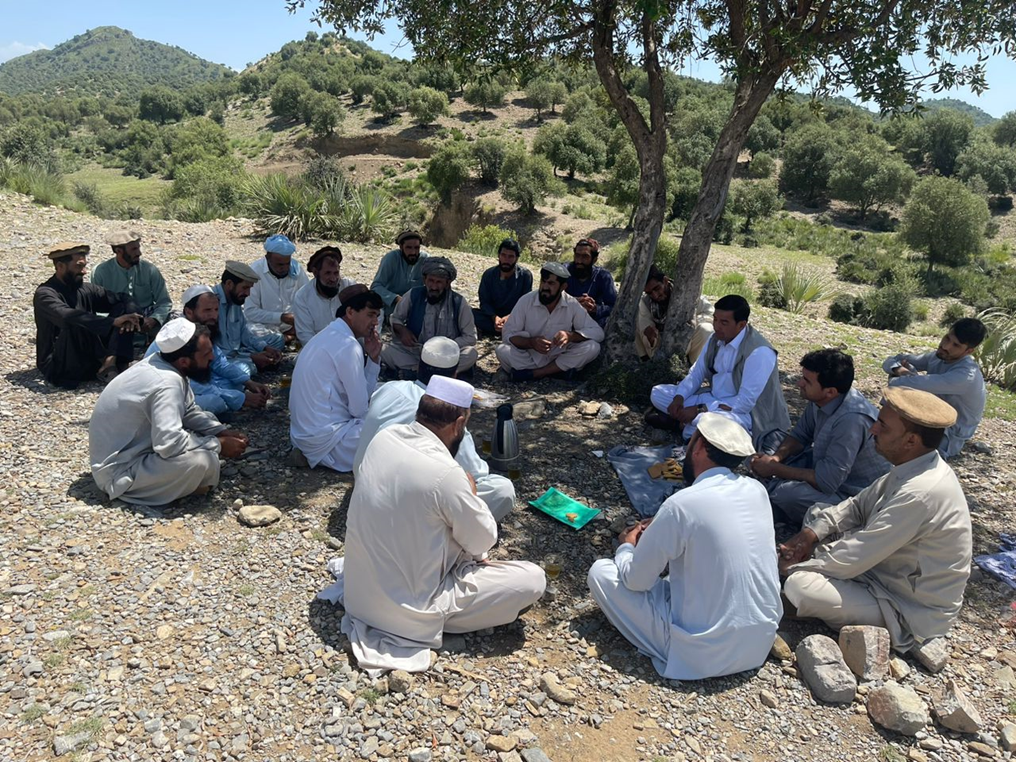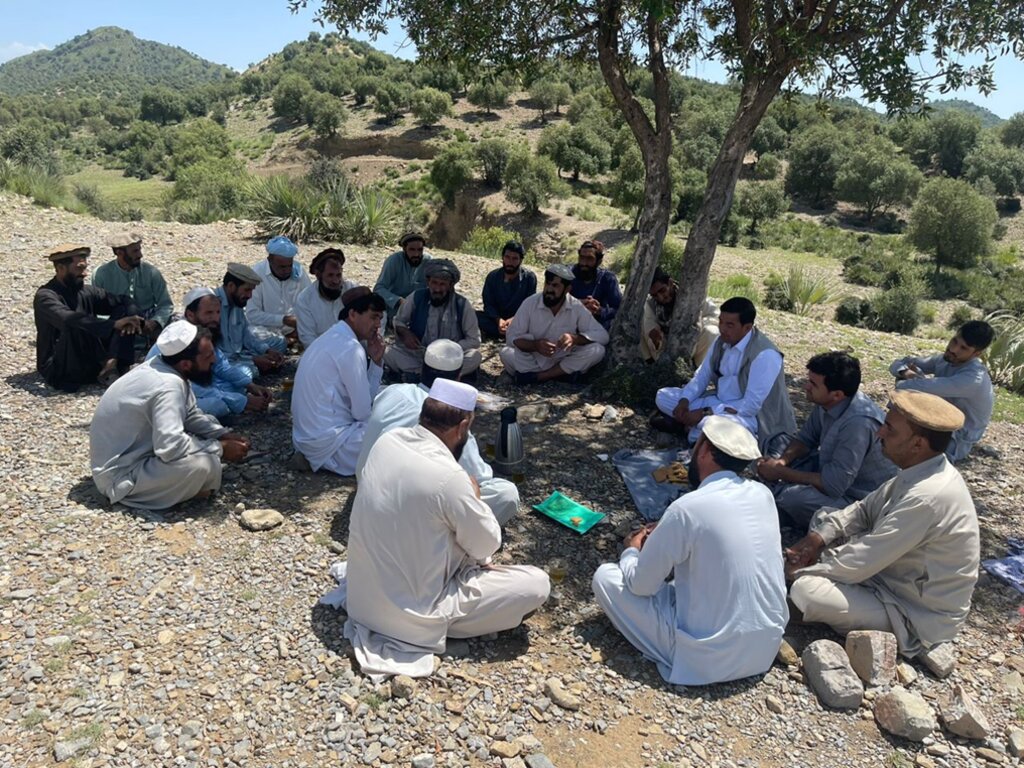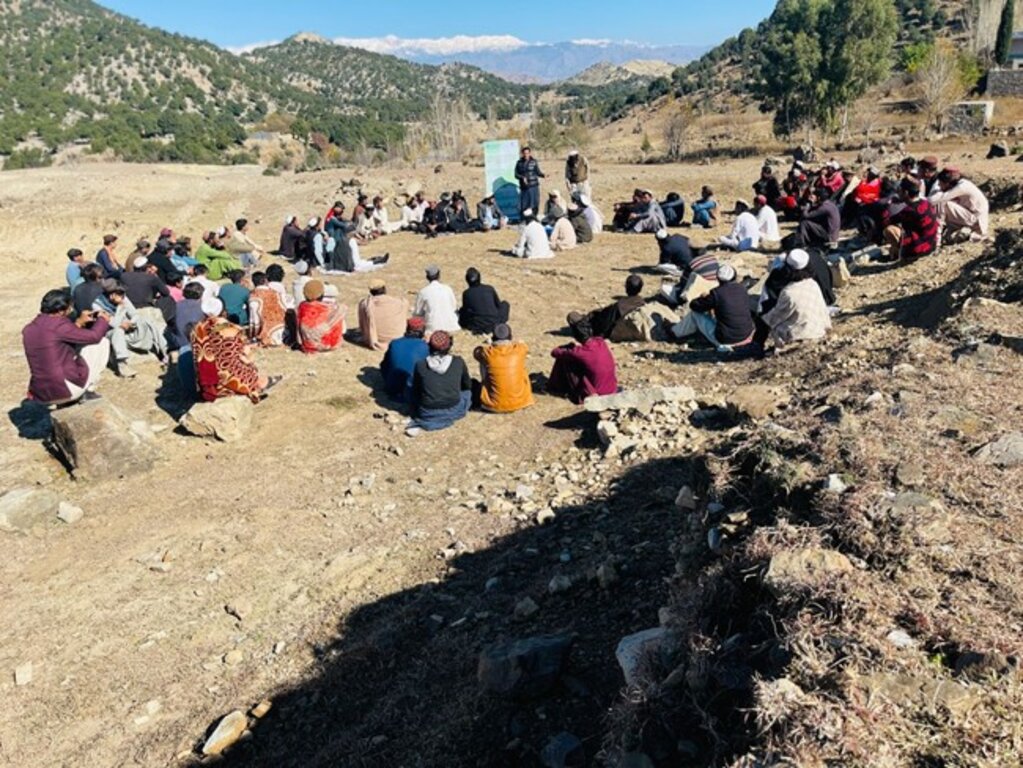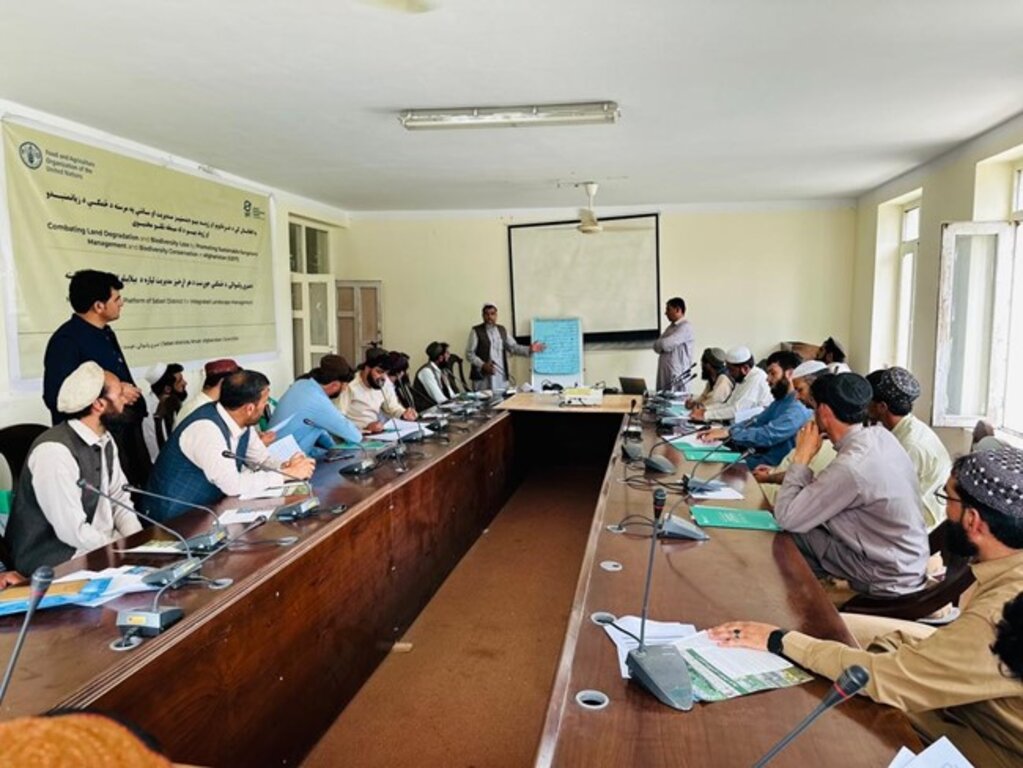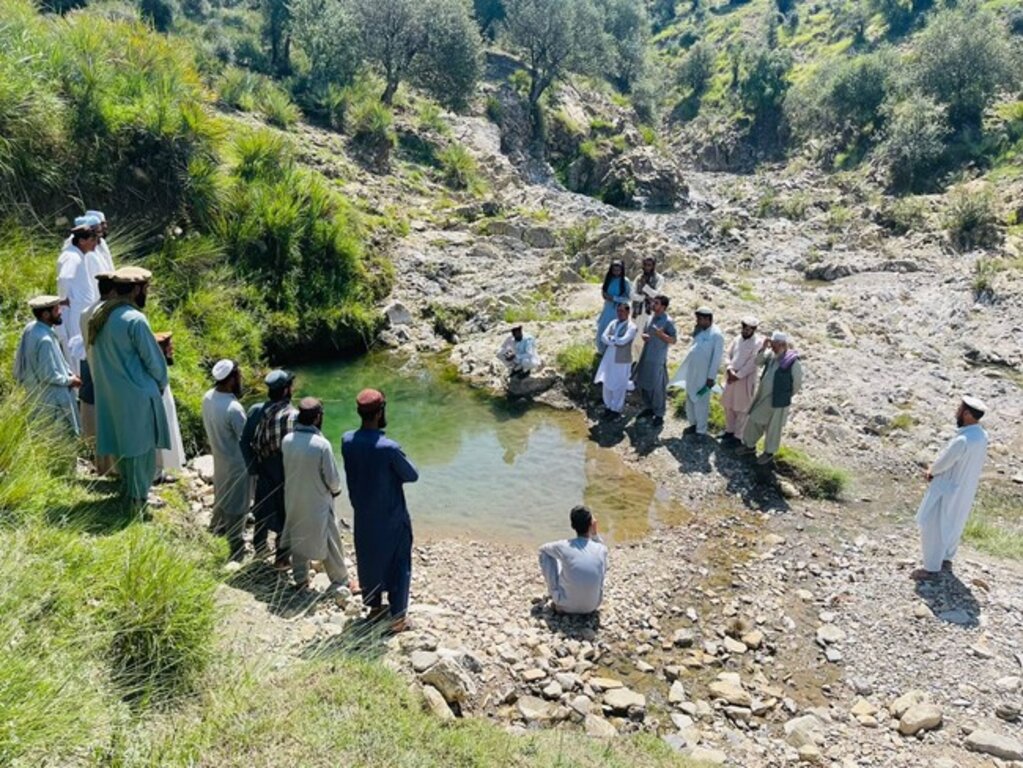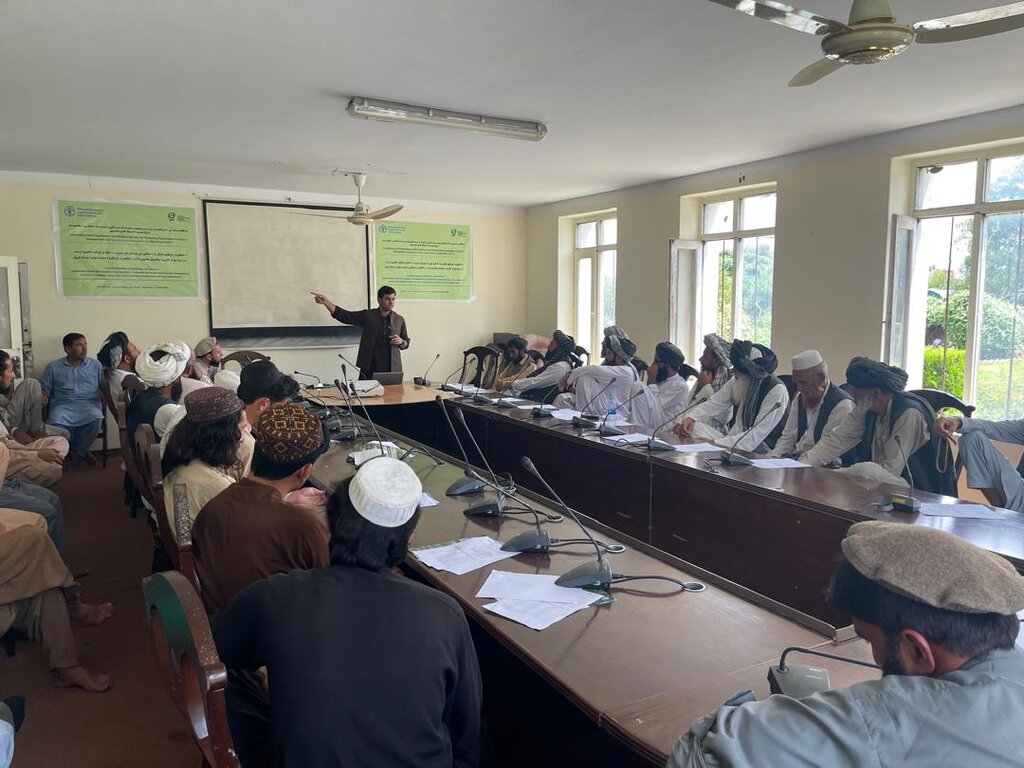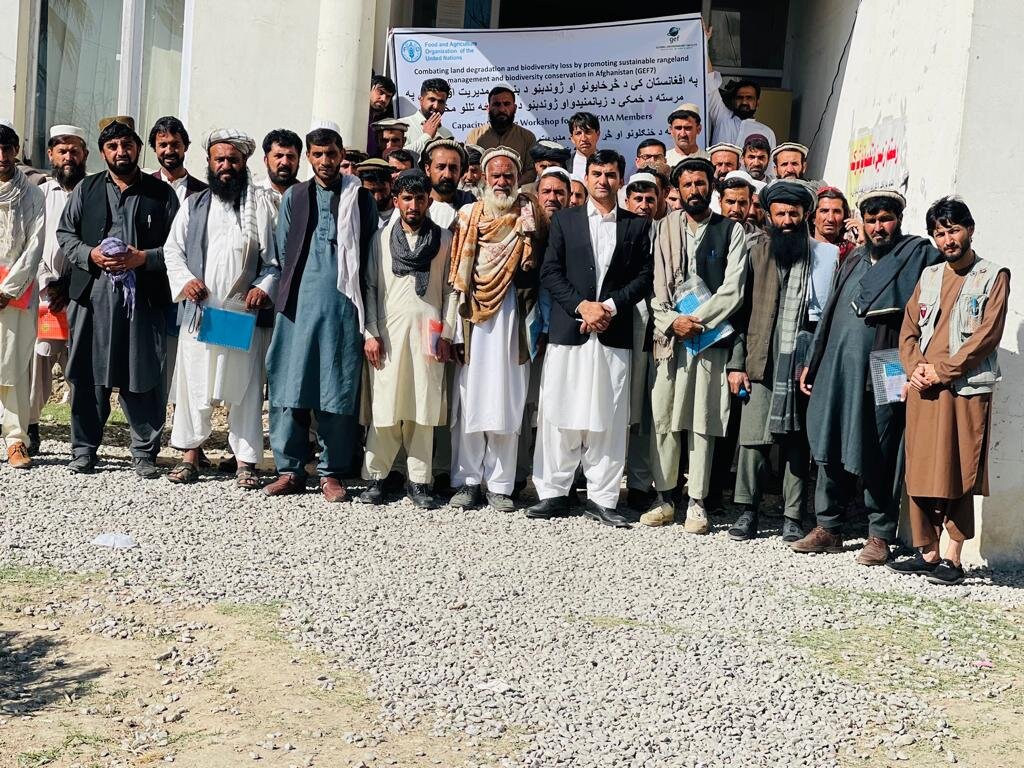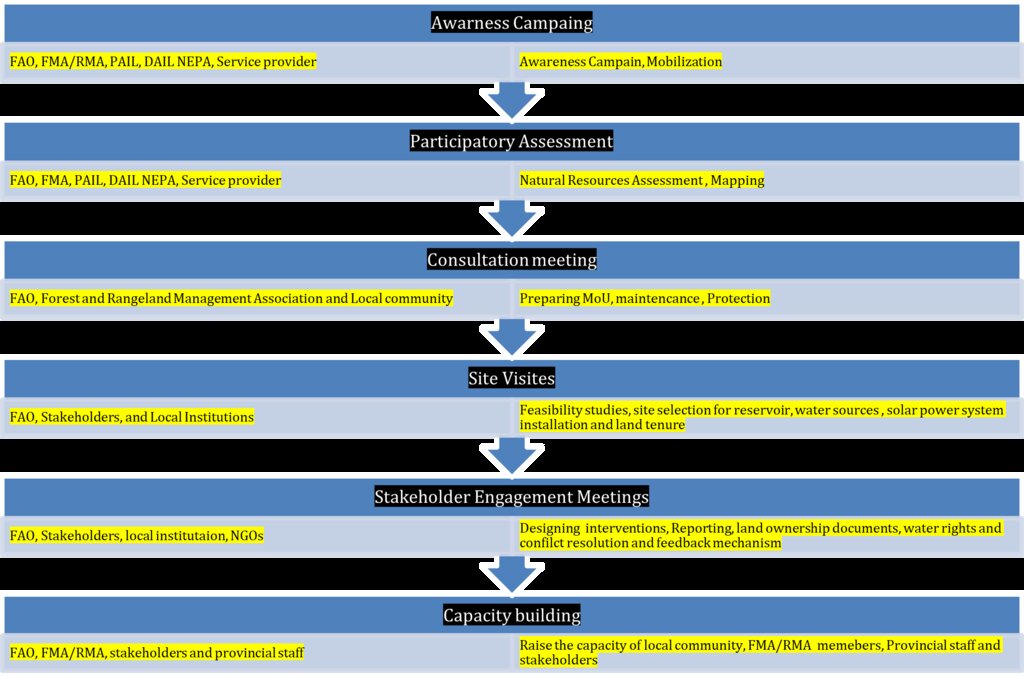Stakeholder collaboration for building Learning Site for landscape restoration [Afghanistan]
- Creation:
- Update:
- Compiler: Mohammad Arif
- Editors: Afghanistan Safi, Megha bajaj, Mohammad Aslam Hasand
- Reviewers: Rima Mekdaschi Studer, Illias Animon, Muhammad Ishaq Safi
دځمکې مخینی د بیارغونې په موخه دښکیلو اړخونو د ګډو هڅو سره د زده کړی ساحی رامینځ ته کول
approaches_7469 - Afghanistan
View sections
Expand all Collapse all1. General information
1.2 Contact details of resource persons and institutions involved in the assessment and documentation of the Approach
land user:
Muhajir Akbar
+93(0) 797166519
Sparkai Forest and Rangeland Management Association
Stara Mila- Sparkai village- Baak district - Khost-Afghanistan
Afghanistan
Name of project which facilitated the documentation/ evaluation of the Approach (if relevant)
Combating land degradation and biodiversity loss by promoting sustainable rangeland management and biodiversity conservation in AfghanistanName of the institution(s) which facilitated the documentation/ evaluation of the Approach (if relevant)
FAO Afghanistan (FAO Afghanistan) - Afghanistan1.3 Conditions regarding the use of data documented through WOCAT
When were the data compiled (in the field)?
21/10/2024
The compiler and key resource person(s) accept the conditions regarding the use of data documented through WOCAT:
Yes
1.4 Reference(s) to Questionnaire(s) on SLM Technologies
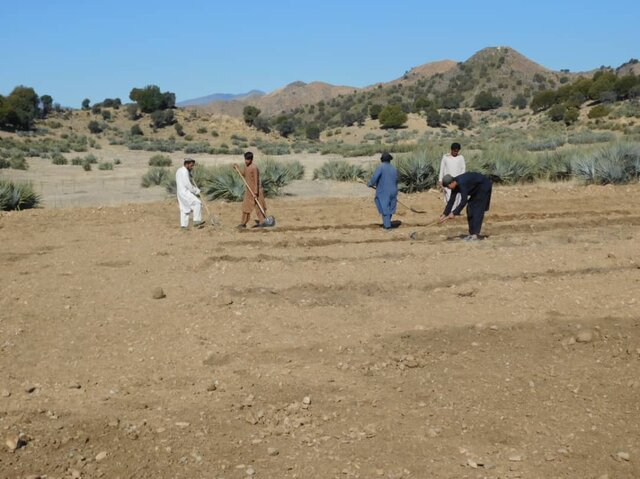
Learning Site to promote Sustainable Land and Forest … [Afghanistan]
The learning site incorporates several key elements of the technology including a solar-powered water lifting system, three reservoirs and an adopted irrigation system. It features demonstration plots for various initiatives, such as tree planting (walnut, almond, pomegranate and mulberry, the cultivation of fodder (alfalfal Mazari palm) and and medicinal plants …
- Compiler: Mohammad Arif
2. Description of the SLM Approach
2.1 Short description of the Approach
To raise awareness and ensure clear role delineation, a series of consultations were held with the local community, the Forest Management/Rangeland Management (FM/RM) association, and other key stakeholders.
Memorandum of Understanding (MoU) that formally outlined the roles and responsibilities of each party was signed. Additionally, the FM/RM association issued a letter of guarantee to support the establishment of a learning site dedicated to promoting best practices in forest and rangeland management. (e.g. cumin) through community’s own contributions.
2.2 Detailed description of the Approach
Detailed description of the Approach:
For Sustainable Land Management (SLM) and biodiversity conservation in Khost, Afghanistan, we started with awareness campaigns in the districts. This mobilization aimed to introduce the project and Community-Based Natural Resource Management (CBNRM) planning, while identifying potential sites for project implementation.
Following the identification of these sites, we launched another awareness campaign to initiate participatory assessments of local natural resources, including forests and rangelands. This led to the development of CBNRM plans, through which we identified gaps in forest and rangeland management that required improvements and new intervention strategies. We also identified the critical issues of forest and rangeland degradation, as well as the needs of the local community, which allowed us to find alternative livelihood interventions to reduce reliance on natural resources.
We visited multiple sites with water availability near forests and rangelands to select the most suitable locations for our interventions.
Once sites were selected, we developed a Memorandum of Understanding (MoU) outlining the roles and responsibilities of each party involved, including FAO, the Forest and Rangeland Management (FM/RM) Association, and the local government. We also prepared a grant letter to ensure the sustainability and ownership of the project by the FM/RM Association.
After the establishment and completion of interventions at the sites, we conducted capacity-building sessions for the local community, FM/RM Association, nomadic groups, and stakeholders from local institutions. These sessions focused on teaching participants how to restore landscapes, specifically forests and rangelands.
The approach includes awareness campaigns, consultation meetings, participatory assessments, resource mobilization, capacity building, and the establishment of a Memorandum of Understanding (MoU) to ensure sustainability. The aim is enabling the local community, FM/RM Association, and stakeholders (Nomads, District and Provincial Agriculture, Irrigation, and Livestock (DAIL/ PAIL),and the National Environmental Protection Agency (NEPA)) to learn good practices for restoring land and forests while utilizing natural resources sustainably. This also involves enhancing the community's capacity to replicate and scale up similar initiatives. The approach is executed through a community-based traditional system, with contributions from both the project team and local communities.
The FM/RM Association has issued a maintenance grantee letter and hired guards to protect the site. Additionally, efforts are being made to mobilize villagers and nomadic groups to refrain from entering the area and grazing their livestock within the designated restoration site.
Key stakeholders include PAIL, NEPA, district entities, community institutions, and the FM/RM Association. PAIL and NEPA play crucial roles in helping the local community resolve land disputes and facilitating discussions related to land, water rights, and more. The local community and FMA/RMA are essential to the interventions, contributing to maintenance, safeguarding, dispute resolution over land, grazing management, irrigation, and replacing dead plants. FMA/RM Association serves as key stakeholder established by the project providing legal MoU, maintenance letters, and facilitating awareness and mobilization on-site while addressing any issues that arise during implementation. Land users appreciate capacity-building sessions during Focus Group discussions and key informant interviews, awareness-raising initiatives, and their involvement in practical implementation. However, they express concerns about cash contributions due to poverty and unemployment, preferring assistance in other forms.
2.3 Photos of the Approach
General remarks regarding photos:
The photos have been taken with low quality smart phone.
2.4 Videos of the Approach
2.5 Country/ region/ locations where the Approach has been applied
Country:
Afghanistan
Region/ State/ Province:
Khost
Further specification of location:
Sparkai Village, Baak district
Comments:
The approach was implemented in Sparkai Village and by the Sparkai Forest and Rangeland Management Association in Baak District, Khost Province. An awareness campaign was conducted, alongside coordination meetings with all stakeholders. We visited various villages in the district to carry out a participatory assessment of natural resources and identify key sites for forest, rangeland, and watershed management. After a series of consultation and stakeholder engagement meetings, we selected the site and signed a Memorandum of Understanding (MoU) for the establishment of the learning site.
Map
×2.6 Dates of initiation and termination of the Approach
Indicate year of initiation:
2023
If precise year is not known, indicate approximate date when the Approach was initiated:
less than 10 years ago (recently)
Year of termination (if Approach is no longer applied):
2024
Comments:
As part of project outputs, a learning site was to be established within the first year, starting in 2022. However, due to the time required for pre-assessment and participatory assessment, as well as community awareness and mobilization efforts, the identification and selection of a suitable site took longer than anticipated. By June 2023, a site was successfully identified namely Stara Mila in Sparkai Village, Baak District, Khost Province. Several key interventions were completed, including the installation of a solar power lifting system, the construction of reservoirs, and the establishment of demonstration areas for restoration. For moving forward, it is essential to sustain and manage these interventions throughout the project's lifespan. The project plans to hand over the management of these facilities to the local community to ensure ownership and long-term sustainability
2.7 Type of Approach
- project/ programme based
2.8 Main aims/ objectives of the Approach
-Strengthen the skills and knowledge of local communities to effectively adopt solar-powered lift irrigation systems and optimize the use of river resources.
-Enable local communities to sustainably manage and utilize their natural resources, ensuring long-term ecological balance.
-Leverage traditional practices and foster local support to enhance future sustainable natural resource management.
-Actively involve youth in development initiatives, promoting their role in managing natural resources and fostering a sense of stewardship.
-Establish a hub that brings together local communities, stakeholders, and students to learn about land and forest management practices.
-Train local communities and stakeholders on transforming unproductive land into productive agricultural and forest areas, thereby enhancing food security and livelihoods.
-Empower local communities to replicate and put to scale successful land restoration and forest management initiatives, promoting sustainable practices and building community resilience.
2.9 Conditions enabling or hindering implementation of the Technology/ Technologies applied under the Approach
social/ cultural/ religious norms and values
- enabling
Foster social participation by promoting women's involvement in decision-making processes and integrating traditional mechanisms to enhance community engagement and inclusivity.
availability/ access to financial resources and services
- hindering
Local communities involved in forest and rangeland management often face significant challenges due to a lack of financial resources. Unemployment, political crises, and traditional norms can further restrict their access to essential funding and services. These barriers hinder their ability to implement sustainable management practices and improve their livelihoods.
institutional setting
- enabling
Forest and Rangeland Management Association (FM/RM A) established
collaboration/ coordination of actors
- enabling
FM/RM A is key stakeholders in Community-Based Natural Resource Management (CBNRM) activities. Local communities and stakeholders regularly hold coordination meetings to collaborate and contribute to various development projects.
legal framework (land tenure, land and water use rights)
- enabling
FMA/RM A serves as a legal entity responsible for managing land tenure and water rights through traditional practices, with support and contributions from government entities.
land governance (decision-making, implementation and enforcement)
- enabling
FMA/RM A and local communities are actively participating in decision-making processes related to land management. Their involvement includes supervision, monitoring, resolving land disputes, implementing policies, and addressing various land-related issues. This collaborative approach ensures that the voices of local stakeholders are heard and considered in all aspects of land governance.
knowledge about SLM, access to technical support
- enabling
Local community, FMA/RM A and stakeholders have access to knowledge, skills about SLM and sustainable forest and rangeland management practices.
workload, availability of manpower
- enabling
This technology has created jobs and provided sufficient manpower to facilitate the implementation of CBNRM interventions.
3. Participation and roles of stakeholders involved
3.1 Stakeholders involved in the Approach and their roles
- community-based organizations
The Forest and Rangeland Management (FM/RM) Association .
FM/RM Association facilitated awareness campaigns, mobilized communities, conducted participatory assessments, and resolved land and water disputes.
- SLM specialists/ agricultural advisers
FAO SLM specialists, community mobilizers, local volunteers, district-level Agriculture, Irrigation and Livestock workers and the National Environmental Protection Officer.
To enhance the roles of stakeholders involved in coordinating forest and rangeland management at district-level, the following should be considered: capacity building, organizing workshops and seminars, facilitating knowledge sharing, improving communication, establishing feedback mechanisms, and fostering community engagement.
- local government
Provincial Agriculture, Irrigation, and Livestock (PAIL), the National Environmental Protection Agency (NEPA) were involved at provincial level.
To improve the roles of stakeholders involved at provincial level in coordination of forest and rangeland management, the following should be considered: conflict resolution mechanism, collaborative partnerships and monitoring and evaluation and the utilization and sustainability of the technology.
- national government (planners, decision-makers)
District governor;
District Urban Development and Land.
Facilitated meetings on natural resource management laws and conflict resolution
If several stakeholders were involved, indicate lead agency:
FAO-Afghanistan
3.2 Involvement of local land users/ local communities in the different phases of the Approach
| Involvement of local land users/ local communities | Specify who was involved and describe activities | |
|---|---|---|
| initiation/ motivation | self-mobilization | Local land users FM/RM Association members called for awareness raising campaigns, mobilization, resolving disputes over the land, participating in participatory assessment, feasibility studies, site identification and site selection. |
| planning | interactive | Local community provided first hand data about the natural resources, indigenous species, for the CBNRM planning. |
| implementation | interactive | The FM/RM Association actively engaged in the implementation process by hiring guards for site security, monitoring activities, and providing human resources for interventions. This collaborative approach ensured effective oversight and community involvement. |
| monitoring/ evaluation | interactive | Local community and stakeholders supervised and monitored the learning site throughout the implementation and up to completion. They provided a guaranteed letter ensuring the sustainability and ongoing maintenance of the learning site. |
3.3 Flow chart (if available)
Description:
The project involved various stakeholders, including the FM/RM Association, Provincial and District Agriculture, Irrigation and Livestock (PAIL/DAIL) departments, the National Environmental Protection Agency (NEPA), and service providers. These organizations participated in awareness campaigns, consultation meetings, participatory assessments, feasibility studies, and site selection.
The FAO technical engineering team designed the solar-powered lifting system and reservoirs, which were implemented through a service provider. Additionally, the FAO team selected forest species for reforestation and demonstration plots. The community, along with the FM/RM association, planted the provided saplings from FAO.
Demonstration plots were prepared, and fencing was installed through a contract with a service provider. The local community and FMA/RMA hired a guard to ensure the site's safety and maintenance.
Key stakeholders, including PAIL, DAIL, NEPA, and district entities, played important roles in meetings, dispute resolution, and providing assistance in accordance with their policies and responsibilities.
3.4 Decision-making on the selection of SLM Technology/ Technologies
Specify who decided on the selection of the Technology/ Technologies to be implemented:
- all relevant actors, as part of a participatory approach
Explain:
All activities, from awareness campaigns to mobilization coordination, participatory assessments, feasibility studies, and decision-making processes, were carried out collaboratively. Every stakeholder actively engaged from the selection phase through implementation to successful completion.
Specify on what basis decisions were made:
- evaluation of well-documented SLM knowledge (evidence-based decision-making)
4. Technical support, capacity building, and knowledge management
4.1 Capacity building/ training
Was training provided to land users/ other stakeholders?
Yes
Specify who was trained:
- land users
- field staff/ advisers
Form of training:
- on-the-job
- farmer-to-farmer
- demonstration areas
- public meetings
Subjects covered:
Sustainable forest and rangeland management, rotational grazing, integrated landscape management, CBNRM planning, biodiversity conservation, demo plots preparation, reforestation, watershed management climate smart agriculture, pastoralist field school, operation and maintenance of the learning site.
Comments:
During the project's initiation, the FAO-GEF7 team conducted comprehensive training sessions for a diverse range of participants, including the local community, forest and rangeland management associations, stakeholders, Kuchies (nomads), youths, and women. These training sessions were designed to cover a broad range of topics essential for sustainable resource management and community engagement.
Participants were introduced to the project's objectives, fundamental principles of Natural Resource Management (NRM), Community-Based Natural Resource Management (CBNRM) planning, the establishment of community-based nurseries, mechanisms for receiving and addressing complaints, sustainable practices for managing forests and rangelands, reforestation methods, watershed management strategies, value chains within forest and rangeland ecosystems, integrated landscape management approaches, techniques for biodiversity conservation, measures for controlling grazing activities, practices for rotational grazing, management of demonstration plots, principles of climate-smart agriculture, pastoralist field schools, and the operation and maintenance of the learning site.
Through these training sessions, the project aimed to equip participants with the knowledge and skills necessary to promote sustainable practices, enhance biodiversity conservation, foster community engagement, and ensure the long-term success of the project's objectives.
4.2 Advisory service
Do land users have access to an advisory service?
Yes
Specify whether advisory service is provided:
- on land users' fields
- At learning site established by local volunteers, District Agriculture Irrigation and Livestock (DAIL) staff and FAO technical team
Describe/ comments:
The FAO technical team collaborates with on-site local volunteers in villages, district agriculture, irrigation, and livestock departments, along with Forest and Rangeland Management Associations, to offer crucial advisory services. These services encompass irrigation techniques, maintenance practices, plantation guidance, establishment of demonstration plots, grazing management strategies, reforestation efforts, implementation of rotational grazing methods, mulching practices, as well as land and forest restoration techniques
4.3 Institution strengthening (organizational development)
Have institutions been established or strengthened through the Approach?
- yes, moderately
Specify the level(s) at which institutions have been strengthened or established:
- local
Describe institution, roles and responsibilities, members, etc.
The Forest and Rangeland Management (FM/RM) Association, in collaboration with the local community, plays a pivotal role in the sustainable management of natural resources. They serve as a central institution for coordinating contributions and assistance in various development projects in the area. Their responsibilities encompass mobilization of manpower, awareness-raising, participatory assessments, feasibility studies, supervision, maintenance, dispute resolution, and more.
Through a mutually agreed-upon Memorandum of Understanding (MoU), these entities are committed to resolving disputes, providing essential information for data collection, irrigation practices, safeguarding the site, working towards sustainability, maintaining the entire system and site, replacing deceased plants, mobilizing when necessary, controlling grazing activities, promoting the sustainable utilization of natural resources, preparing land for demonstration plots, and establishing forest nurseries.
Specify type of support:
- financial
- capacity building/ training
- equipment
Give further details:
FAO has supplied saplings, tools, materials, constructed reservoirs and solar power water lifting system and alternative livelihood interventions. They have also conducted capacity-building trainings, on-job trainings, Pastoralist field school trainings, and community engagement for planting saplings. Additionally, they have facilitated on-site activities, mobilization efforts, awareness campaigns, coordination meetings, safeguarding of the forest and rangeland, and encouraged local community involvement. Furthermore, they have actively engaged youths and women in every intervention implementation and have played a vital role in resolving disputes during the implementation process.
4.4 Monitoring and evaluation
Is monitoring and evaluation part of the Approach?
Yes
Comments:
The FM/RM Association, local community members, and the FAO technical team diligently monitored every step of the process from the initiation of the approaches to their completion. They collaboratively conducted site visits to monitor the progress, document their findings, and record observations in both the logbook and KOBO system.
If yes, is this documentation intended to be used for monitoring and evaluation?
No
4.5 Research
Was research part of the Approach?
No
5. Financing and external material support
5.1 Annual budget for the SLM component of the Approach
If precise annual budget is not known, indicate range:
- 2,000-10,000
Comments (e.g. main sources of funding/ major donors):
GEF and Afghan government are funding the project with the applied SLM technologies and approach.
5.2 Financial/ material support provided to land users
Did land users receive financial/ material support for implementing the Technology/ Technologies?
Yes
If yes, specify type(s) of support, conditions, and provider(s):
The FAO provided water pumps, solar panels, pipe fittings, construction of water reservoirs, barbed wire for fencing, saplings for reforestation, seeds for reseeding, as well as training and technical support. The local community has prohibited grazing of the site to ensure long-term sustainability. Additionally, the government will offer support in resolving any conflicts and providing further livelihood interventions.
5.3 Subsidies for specific inputs (including labour)
- none
If labour by land users was a substantial input, was it:
- rewarded with other material support
Comments:
The FM/RM Association collaborates closely with the local community, both acting as voluntary stewards of the land. Together, they engage in a range of activities, including tree planting, irrigation management, site maintenance, and conservation efforts. In certain instances, FAO provides vital support to the most vulnerable individuals within the community. Notably, FAO offers alternative livelihood interventions to enhance economic opportunities and sustainability. These interventions may include the provision of resources such as micro greenhouses, high-quality seeds, equipment for dairy processing, hygiene toolkits, solar cookers, trainings and other necessary materials. By targeting the most vulnerable members of the community, including women, the association aims to empower them and encourage their active participation in various development initiatives. This holistic approach not only fosters environmental stewardship but also promotes social inclusion and economic resilience within the community. Through collaborative efforts and targeted support, the association and the local community work hand in hand to create a more sustainable and equitable future for all stakeholders involved.
5.4 Credit
Was credit provided under the Approach for SLM activities?
No
5.5 Other incentives or instruments
Were other incentives or instruments used to promote implementation of SLM Technologies?
Yes
If yes, specify:
FAO offered field visits, training, and small-scale income-generating interventions to enhance household food security and support alternative livelihoods for land users and local communities.
6. Impact analysis and concluding statements
6.1 Impacts of the Approach
Did the Approach empower local land users, improve stakeholder participation?
- No
- Yes, little
- Yes, moderately
- Yes, greatly
FAO has supported various interventions, including the construction of reservoirs, installation of solar-powered water lifting systems, and provision of seeds and saplings for reforestation, along with exploring alternative livelihood opportunities. A key element of these interventions is the active participation of local land users in decision-making processes and their empowerment to drive sustainable outcomes.
Did the Approach enable evidence-based decision-making?
- No
- Yes, little
- Yes, moderately
- Yes, greatly
Evidence-based decision-making was facilitated by involving participatory assessments, site selection, preparation of demonstration plots, and sapling planting. This hands-on, inclusive approach allowed for data collection and analysis ensuring that decisions were knowledge-based.
Did the Approach help land users to implement and maintain SLM Technologies?
- No
- Yes, little
- Yes, moderately
- Yes, greatly
Capacity building and training sessions, awareness-raising radio messages broadcasted on land and forest management, brochures and manuals supported a comprehensive outreach strategy.
Did the Approach improve coordination and cost-effective implementation of SLM?
- No
- Yes, little
- Yes, moderately
- Yes, greatly
Conducted regular mobilization efforts, established Forest and Rangeland Management Association facilitated a coordination platform involving local community and government entities. Signed a Memorandum of Understanding (MoU) outlining roles and responsibilities for technology implementation and ensuring sustainability.
Did the Approach mobilize/ improve access to financial resources for SLM implementation?
- No
- Yes, little
- Yes, moderately
- Yes, greatly
The recently established Forest and Rangeland Management Association requires increased advocacy to gain recognition among NGOs, donors, and government entities. It serves as a focal point in the area for coordinating development projects, with a dedicated social fund for maintenance. They are actively seeking support from NGOs and other organizations to secure funding for these impactful initiatives.
Did the Approach improve knowledge and capacities of land users to implement SLM?
- No
- Yes, little
- Yes, moderately
- Yes, greatly
The establishment of a learning site for Sustainable Land Management (SLM) practices has significantly enhanced community capacity. Residents have acquired knowledge and skills enabling them to implement various SLM technologies including reforestation, afforestation, and improved land management practices for effective land restoration.
Did the Approach improve knowledge and capacities of other stakeholders?
- No
- Yes, little
- Yes, moderately
- Yes, greatly
With access to the Sustainable Land Management (SLM) learning site, the local community and government have enhanced their capacities. Regular visits to the site enable them to exchange knowledge, skills, and experiences, fostering continuous improvement and collaboration for future advancements in land management practices.
Did the Approach build/ strengthen institutions, collaboration between stakeholders?
- No
- Yes, little
- Yes, moderately
- Yes, greatly
Establishing Forest and Rangeland Management has fostered sub-coordination meetings and joint training sessions among local communities, government departments, DAIL and NEPA near forest and rangeland areas. This collaboration strengthens partnerships, enhancing sustainable land and resource management practices in the province.
Did the Approach mitigate conflicts?
- No
- Yes, little
- Yes, moderately
- Yes, greatly
Registered with the government and traditional bodies, the FMA/RMA from the local community has successfully resolved numerous conflicts and continues to address issues through established mechanisms.
Did the Approach empower socially and economically disadvantaged groups?
- No
- Yes, little
- Yes, moderately
- Yes, greatly
Collaborative efforts have provided vulnerable community groups with access to alternative livelihood interventions and a platform to voice their needs for assistance and rights regarding natural resources.
Did the Approach improve gender equality and empower women and girls?
- No
- Yes, little
- Yes, moderately
- Yes, greatly
Gender inclusion is prioritized across all interventions, particularly in alternative livelihood programs aimed at household income generation and enhancing food security
Did the Approach encourage young people/ the next generation of land users to engage in SLM?
- No
- Yes, little
- Yes, moderately
- Yes, greatly
Conducted an awareness campaign in nearby schools, educating students and distributing informative brochures.
Did the Approach improve issues of land tenure/ user rights that hindered implementation of SLM Technologies?
- No
- Yes, little
- Yes, moderately
- Yes, greatly
The established Forest and Rangeland Management Association, formal bodies elected by the local community, are resolving land tenure issues and rights for implementing Sustainable Land Management (SLM) technologies
Did the Approach lead to more sustainable use/ sources of energy?
- No
- Yes, little
- Yes, moderately
- Yes, greatly
Through the Forest and Rangeland Management Association initiative, the local community has acquired essential knowledge to utilize their natural resources sustainably, including using solar panels for lifting of water to irrigate reforested land
Did the Approach improve the capacity of the land users to adapt to climate changes/ extremes and mitigate climate related disasters?
- No
- Yes, little
- Yes, moderately
- Yes, greatly
The local community and land users have learned to implement flood control measures, prevent deforestation, regulate grazing and fires in the forest, and enhance water table recharge through practices that improve the vegetation cover.
Did the Approach lead to employment, income opportunities?
- No
- Yes, little
- Yes, moderately
- Yes, greatly
Initiated short-term employment opportunities with the potential for significant expansion through ongoing initiatives.
6.2 Main motivation of land users to implement SLM
- increased production
This initiative has led to an increase in improved pastureland for livestock, ensuring sustainable income generation for households in the community.
- reduced land degradation
The local community has learned various practices implemented at the learning site and is now applying these techniques to their degraded land. They have adopted rotational grazing and controlled grazing methods, as well as planting cuttings along riverbanks. These efforts have significantly reduced land degradation.
- reduced risk of disasters
The implementation of various technologies has led to a notable decrease in floods, landslides, fires, and droughts within the region.
- rules and regulations (fines)/ enforcement
The local communities, along with the established Forest and Rangeland Management Associations from several villages, serve as the executive bodies for natural resource management. Each community consults the FM/RM Association for decision-making roles and has developed its own regulations for managing natural resources and the learning site.
- affiliation to movement/ project/ group/ networks
The establishment of the FM/RM Association and the learning site has facilitated the formation of a cohesive group and network comprising various stakeholders. This platform enables learning and collaboration on sustainable land management practices, particularly focusing on forest and rangeland restoration.
- environmental consciousness
The local community, students, and stakeholders have acquired crucial knowledge in environmental safeguarding, sustainable utilization, and restoration practices.
- enhanced SLM knowledge and skills
By establishing a learning site focused on sustainable land and forest management practices, the FM/RM association has actively engaged various stakeholders and the local community. Through these interactions, knowledge and skills vital for the sustainable management of land and forests have been significantly enhanced.
- conflict mitigation
The FM/RM association stands as a formal institution within our local community, dedicated to addressing conflicts concerning land and natural resources. Through their efforts, conflicts are being effectively resolved, ensuring that the rights of all parties involved are duly considered and upheld.
6.3 Sustainability of Approach activities
Can the land users sustain what has been implemented through the Approach (without external support)?
- yes
If yes, describe how:
As we strive to combat land degradation, enhance resilience within the local community, and conserve biodiversity, the system has been entrusted to the FMA/RM Association and the local community. This collaborative approach is designed to ensure long-term sustainability, enabling the community to effectively utilize, maintain, and eventually pass on the system to future generations.
6.4 Strengths/ advantages of the Approach
| Strengths/ advantages/ opportunities in the land user’s view |
|---|
| The FM/RM Associaion of the local community functions as an executive body dedicated to effective management of natural resources. It has established itself as a strong institution, collaborating closely with various stakeholders to ensure sustainable development for future projects. This proactive approach enhances community engagement and promotes responsible stewardship of local resources. |
| Conducting awareness campaigns through in-person events and radio broadcasts on forest, rangeland management, and biodiversity conservation is vital to encourage the local community to utilize natural resources sustainably. |
| Involving the local community in consultations and decision-making fosters a sense of ownership, encouraging sustainable system utilization. |
| Involving youth in FMA/RM Association and decision-making empowers them as future leaders representing the local community in development activities. This ensures that future generations can learn sustainable land and forest management practices. |
| Strengths/ advantages/ opportunities in the compiler’s or other key resource person’s view |
|---|
| Working closely with the community is essential due to the presence of potential land disputes, indigenous knowledge, and decades of information that can provide significant advantages for any natural resources management efforts. |
| Uniting the local community and establishing an official Forest and Rangeland Management Association as a platform can significantly enhance the smooth implementation of projects and ensure the long-lasting sustainability of the system. |
| Awareness campaigns, mobilization, consultation, capacity building, and the creation of Memorandums of Understanding (MoU) that outline roles and responsibilities are essential elements of Sustainable Land Management (SLM) approaches. These components are crucial for effectively transferring the management of the system to local communities, enabling them to sustainably utilize the land over time. |
| It serves as an educational center where the younger generation can visit to acquire knowledge on natural resource management, biodiversity conservation, combating land degradation, and grazing management. This exposure can inspire them to actively engage in development projects and revive traditional systems to conserve forests and rangelands for sustainable use. |
6.5 Weaknesses/ disadvantages of the Approach and ways of overcoming them
| Weaknesses/ disadvantages/ risks in the land user’s view | How can they be overcome? |
|---|---|
| We face several challenges, including land tenure issues, land disputes, and water rights. These problems often remain unresolved due to nepotism and poverty, with influential individuals in government hindering progress. Additionally, traditional mechanisms for conflict resolution are sometimes overlooked by the government, complicating efforts to address these critical issues. | We need to prioritize advocacy and lobbying efforts, as well as increase the frequency of sub-coordination meetings with the government. This will help establish formal institutions within our community and ensure that our decisions are respected in all circumstances. |
| The challenges of controlling Kuchies settlement and overgrazing are exacerbated by insufficient support from neighboring villages, districts, and government authorities. | To address this issue, it is essential to establish collaborative initiatives that encourage sustainable land management practices, promote community engagement, and foster partnerships among stakeholders. By developing comprehensive support systems, we can effectively mitigate overgrazing and ensure the sustainable use of natural resources. |
| The FMA/RM Associaton is not widely recognized among stakeholders. As a result, it is challenging for NGOs and donors to effectively coordinate with them for consultations and needs assessments. | To enhance recognition of FMA/RM Association among stakeholders, we should conduct workshops and seminars that highlight their roles and benefits. Establishing a dedicated platform for NGOs and donors will facilitate ongoing dialogue and information sharing. Actively engaging stakeholders in joint assessments will help identify community needs while ensuring FMA/RMA is included in discussions. Additionally, fostering partnerships with local government and other organizations will increase visibility and support for these initiatives. |
| The absence of youth committees and the weakening of local traditional systems pose significant challenges for future projects. | We should actively involve youth by forming committees and strengthening the local traditional system. Additionally, we can assist the community in documenting these mechanisms formally to ensure they are preserved for future reference. |
| Weaknesses/ disadvantages/ risks in the compiler’s or other key resource person’s view | How can they be overcome? |
|---|---|
| The local community lacks sufficient knowledge about indigenous plants and natural resources. | We should establish indigenous demonstration plots and create a comprehensive database to record all relevant data. Additionally, it is important to develop a proper mechanism for data collection to ensure valuable information is preserved for future generations. |
| The lack of knowledge and high illiteracy rates are major issues, compounded by the absence of a proper curriculum in schools that addresses indigenous knowledge and natural resources in the country. | We need to enhance the capacity of local communities regarding indigenous plant resources by developing a curriculum to be taught in schools for the younger generation. Additionally, increasing field visits will help students and community members gain firsthand knowledge of their local resources. |
| The lack of an effective grazing management mechanism has led to conflicts among nomadic communities and Kuchies (Nomads) with little attention from the government or local organizations. | The PAIL departments, along with NEPA, district entities, FMA/RM Association and academic departments, should collaborate to develop an effective mechanism for grazing management and rangeland restoration. |
| The lack of knowledge regarding the maintenance of solar-powered lifting systems, coupled with insufficient technical skills for troubleshooting and repairs, poses significant challenges. | We should provide training to the local community on how to operate the solar-powered lifting systems and offer guidance on troubleshooting and repairs. Additionally, we can connect them with mechanics for further hands-on training. |
7. References and links
7.1 Methods/ sources of information
- field visits, field surveys
6
- interviews with land users
20
- interviews with SLM specialists/ experts
4
7.2 References to available publications
Title, author, year, ISBN:
N/A
7.3 Links to relevant information which is available online
Title/ description:
N/A
Links and modules
Expand all Collapse allLinks

Learning Site to promote Sustainable Land and Forest … [Afghanistan]
The learning site incorporates several key elements of the technology including a solar-powered water lifting system, three reservoirs and an adopted irrigation system. It features demonstration plots for various initiatives, such as tree planting (walnut, almond, pomegranate and mulberry, the cultivation of fodder (alfalfal Mazari palm) and and medicinal plants …
- Compiler: Mohammad Arif
Modules
No modules


